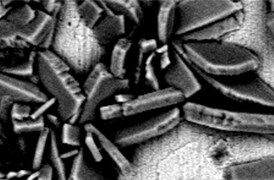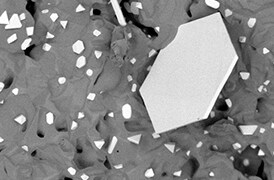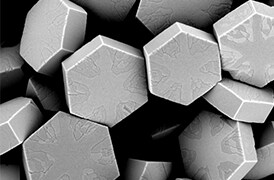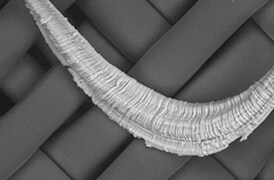Search Thermo Fisher Scientific

Scanning Electron Microscopes
Phenom XL G2 Desktop SEM
Desktop SEM with increased chamber size for large samples up to 100 mm x 100 mm.
Download datasheet
Phenom XL G2 Desktop SEM applications
The next-generation Thermo Scientific Phenom XL G2 Desktop Scanning Electron Microscope (SEM) automates your quality control process, providing accurate, reproducible results while freeing up time for value-added work.
The Phenom XL G2 Desktop SEM allow you to:
- Obtain the quality information you need to discover failures early and rapidly adjust your production process when needed.
- Automate quality control to process a high volume of samples with fewer chances of human error.
- Get up to speed quickly with an all-new, easy-to-learn interface ideal for a wide range of applications.
The Phenom XL G2 Desktop SEM features full-screen images and an average time-to image of 60 seconds. The unique CeB6 electron source offers a long lifetime with less maintenance. The small form factor requires little lab space, allowing you to place the microscope exactly where you need it.
Phenom XL G2 Argon-Compatible Desktop SEM
The Thermo Scientific Phenom XL G2 Argon-Compatible Desktop Scanning Electron Microscope (SEM) automates your workflows while providing a stable, non-reactive environment for your reactive sample research.
The Phenom XL G2 Argon-Compatible Desktop SEM offers your research:
- A non-reactive environment to conduct reactive sample research on samples such as solid state lithium batteries
- A modality where you can have sample preparation and SEM/EDX analysis in the same workspace
- A safer way to interface with highly volatile samples such as solid state lithium, enabling the next generation of longer-lasting, eco-friendly batteries
The Phenom XL G2 Argon-Compatible Desktop SEM boasts the same 60-second time to image as the Phenom XL G2 SEM, while also being able to be placed in an argon glove box, assuring the safe analysis of solid state lithium.
Download Phenom XL G2 Argon-Compatible Desktop SEM Datasheet
Automation
The Phenom XL G2 Desktop SEM is standardly accessible via the Phenom Programming Interface (PPI), a powerful method for controlling the Phenom XL G2 Desktop SEM via Python scripting. If the user has a SEM workflow with repetitive work to analyze particles, pores, fibers or large SEM images, the instrument can do so automatically.
Long-lifetime CeB₆ source
The long-lifetime CeB₆ (cerium hexaboride) source has several advantages. First is the high brightness it provides compared to tungsten, making it much easier for many users to obtain high quality images with many details. Secondly, the lifetime of the source is very long and maintenance can be scheduled.
Eucentric sample holder
In many SEM applications, a user can gain more insight into sample properties if the sample can be tilted and rotated. The optional eucentric sample holder enables eucentric tilt and rotation, making research and analysis faster and more accurate.
Element identification (EID)
The Phenom XL G2 Desktop SEM can be equipped with an optional energy-dispersive X-ray spectroscopy (EDS) detector to obtain more material insights with element identification via X-ray analysis.
Step-by-step data collection
The dedicated software package elemental identification software package (EID) is used to control the fully integrated EDS detector. The intuitive step-by-step process within the EID software helps the user to collect all X-ray results in an organized and structured way.
SEM/EDX preparation and analysis in the same workspace
When placed in an argon glove box, this desktop SEM setup enables your research on solid state lithium batteries since it decreases the risk of sample volatility or sample degradation due to lithium oxidation.
Built-in assurance
This desktop SEM helps you maintain sample integrity by eliminating the need to move your samples to different instruments, saving time and resources.
Fostering the goal of a safe lithium battery
This solution allows you to research solid state lithium batteries safely, enabling the next generation of longer-lasting, eco-friendly, more versatile lithium batteries.
Dry room compatibility
This system has been tested and approved to work in dry room environments with dew temperatures as low as -65 0C.

ChemiSEM Technology
Thermo Scientific ChemiSEM Technology revolutionizes and simplifies EDS analysis by fully integrating SEM and EDS functions into a single, cohesive user interface. Based on live quantification and building on decades of expertise in EDS analysis, the technology provides elemental information quickly and easily, guaranteeing reliable results in less time. ChemiSEM Technology now comes with a powerful new feature: ChemiPhase. ChemiPhase identifies unique phases with a big data approach, finding minor and trace elements while eliminating user bias and reducing possible mistakes.
| Electron optical |
|
| Electron optical magnification range |
|
| Light optical magnification |
|
| Resolution |
|
| Image resolution options |
|
| Acceleration voltages |
|
| Vacuum levels |
|
| Detector |
|
| Sample size |
|
| Sample loading time |
|
Webinar: Automate Your Quality Control
In this on-demand webinar, we show how you can improve the quality control process with the next generation in automated desktop analysis. By watching the webinar, you’ll learn how to:
- Obtain the quality information you need to discover failures early and rapidly adjust your production process when needed.
- Automate quality control to process a high volume of samples with fewer chances of human error. (We have both a customized and standard solution, depending on the need.)
- Get up to speed quickly with an all-new, easy-to-learn interface ideal for a wide range of applications.
Webinar: Scanning electron microscopy: selecting the right technology for your needs
This on-demand webinar has been designed to help you decide which SEM best meets your unique needs. We present an overview of Thermo Fisher Scientific SEM technology for multi-user research labs and focus on how these wide-ranging solutions deliver performance, versatility, in situ dynamics and faster time to results. Watch this webinar if you are interested in:
- How the needs for different microanalysis modalities are met (EDX, EBSD, WDS, CL, etc.).
- How samples are characterized in their natural state without the need for sample preparation.
- How new advanced automation allows researchers to save time and increase productivity.
Webinar: Automate Your Quality Control
In this on-demand webinar, we show how you can improve the quality control process with the next generation in automated desktop analysis. By watching the webinar, you’ll learn how to:
- Obtain the quality information you need to discover failures early and rapidly adjust your production process when needed.
- Automate quality control to process a high volume of samples with fewer chances of human error. (We have both a customized and standard solution, depending on the need.)
- Get up to speed quickly with an all-new, easy-to-learn interface ideal for a wide range of applications.
Webinar: Scanning electron microscopy: selecting the right technology for your needs
This on-demand webinar has been designed to help you decide which SEM best meets your unique needs. We present an overview of Thermo Fisher Scientific SEM technology for multi-user research labs and focus on how these wide-ranging solutions deliver performance, versatility, in situ dynamics and faster time to results. Watch this webinar if you are interested in:
- How the needs for different microanalysis modalities are met (EDX, EBSD, WDS, CL, etc.).
- How samples are characterized in their natural state without the need for sample preparation.
- How new advanced automation allows researchers to save time and increase productivity.

Control de proceso
La industria moderna exige un alto rendimiento con una calidad superior, un equilibrio que se mantiene a través de un control de procesos sólido. Las herramientas SEM y TEM con software de automatización exclusivo proporcionan información rápida y multiescala para la supervisión y la mejora de procesos.

Control de calidad
El control y garantía de calidad son esenciales en la industria moderna. Ofrecemos una gama de herramientas de EM y espectroscopía para el análisis multiescala y multimodal de defectos, lo que le permite tomar decisiones fiables e informadas para el control y la mejora de procesos.

Investigación sobre materiales fundamentales
Se investigan nuevos materiales a escalas cada vez más pequeñas para lograr el máximo control de sus propiedades físicas y químicas. La microscopía electrónica proporciona a los investigadores información clave sobre una amplia variedad de características materiales a escala nanométrica.

Pulcritud
Más que nunca, la fabricación moderna necesita componentes fiables y de calidad. Con la microscopía electrónica de barrido, el análisis de limpieza de las piezas se puede llevar a cabo internamente, lo que le proporciona una amplia gama de datos analíticos y acorta su ciclo de producción.
_Technique_800x375_144DPI.jpg)
Análisis elemental EDS
EDS proporciona información de composición vital sobre las observaciones de microscopio electrónico. En concreto, nuestros exclusivos sistemas de detectores Super-X y Dual-X añaden opciones para mejorar el rendimiento y/o la sensibilidad, permitiendo optimizar la adquisición de datos para cumplir con sus prioridades de investigación.
_Technique_800x375_144DPI.jpg)
Tomografía EDS en 3D
La investigación de materiales modernos depende cada vez más del análisis a nanoescala en tres dimensiones. La caracterización en 3D, incluidos los datos de composición para el contexto químico y estructural completo, es posible con EM en 3D y espectroscopia de rayos X dispersiva.

Asignación elemental a escala atómica con EDS
El EDS de resolución atómica proporciona un contexto químico incomparable para el análisis de materiales al diferenciar la identidad elemental de los átomos individuales. Cuando se combina con TEM de alta resolución, es posible observar la organización precisa de los átomos en una muestra.

Análisis de escala múltiple
Los novedosos materiales se deben analizar a una resolución cada vez mayor, manteniendo el contexto más amplio de la muestra. El análisis de escala múltiple permite la correlación de varias herramientas y modalidades de obtención de imágenes, tales como microTC de rayos X, DualBeam, PFIB láser, SEM y TEM.
_Technique_800x375_144DPI.jpg)
Análisis elemental EDS
EDS proporciona información de composición vital sobre las observaciones de microscopio electrónico. En concreto, nuestros exclusivos sistemas de detectores Super-X y Dual-X añaden opciones para mejorar el rendimiento y/o la sensibilidad, permitiendo optimizar la adquisición de datos para cumplir con sus prioridades de investigación.
_Technique_800x375_144DPI.jpg)
Tomografía EDS en 3D
La investigación de materiales modernos depende cada vez más del análisis a nanoescala en tres dimensiones. La caracterización en 3D, incluidos los datos de composición para el contexto químico y estructural completo, es posible con EM en 3D y espectroscopia de rayos X dispersiva.

Asignación elemental a escala atómica con EDS
El EDS de resolución atómica proporciona un contexto químico incomparable para el análisis de materiales al diferenciar la identidad elemental de los átomos individuales. Cuando se combina con TEM de alta resolución, es posible observar la organización precisa de los átomos en una muestra.

Análisis de escala múltiple
Los novedosos materiales se deben analizar a una resolución cada vez mayor, manteniendo el contexto más amplio de la muestra. El análisis de escala múltiple permite la correlación de varias herramientas y modalidades de obtención de imágenes, tales como microTC de rayos X, DualBeam, PFIB láser, SEM y TEM.
Servicios de microscopía electrónica para
la ciencia de materiales
Para garantizar un rendimiento óptimo del sistema, le proporcionamos acceso a una red de expertos de primer nivel en servicios de campo, asistencia técnica y piezas de repuesto certificadas.








